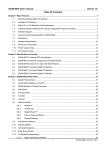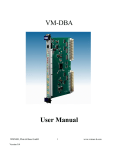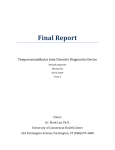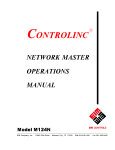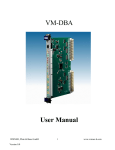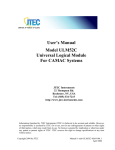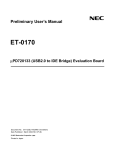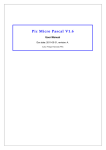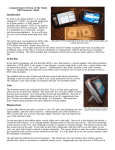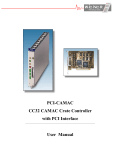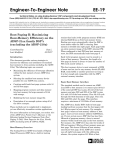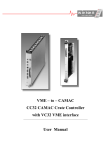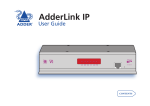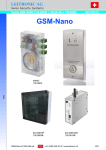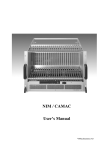Download CC-USB User Manual
Transcript
CC-USB
User Manual
WIENER, Plein & Baus GmbH
Rev. 2.02, May 8, 2006
1
www.wiener-d.com
General Remarks
The only purpose of this manual is a description of the product. It must not be interpreted a
declaration of conformity for this product including the product and software.
W-Ie-Ne-R revises this product and manual without notice. Differences of the description in
manual and product are possible.
W-Ie-Ne-R excludes completely any liability for loss of profits, loss of business, loss of use or
data, interrupt of business, or for indirect, special incidental, or consequential damages of any
kind, even if W-Ie-Ne-R has been advises of the possibility of such damages arising from any
defect or error in this manual or product.
Any use of the product which may influence health of human beings requires the express
written permission of W-Ie-Ne-R.
Products mentioned in this manual are mentioned for identification purposes only. Product
names appearing in this manual may or may not be registered trademarks or copyrights of their
respective companies.
No part of this product, including the product and the software may be reproduced, transmitted,
transcribed, stored in a retrieval system, or translated into any language in any form by any
means with the express written permission of W-Ie-Ne-R.
CC-USB and VM-USB are designed by JTEC Instruments.
WIENER, Plein & Baus GmbH
2
www.wiener-d.com
Table of contents:
1
General Description ........................................................................................................ 5
1.1
CC-USB Features......................................................................................................... 5
1.2
Read-out Modes ........................................................................................................... 5
1.3
CC-USB Front panel .................................................................................................... 6
1.4
Technical Data.............................................................................................................. 7
1.5
Power Consumption ..................................................................................................... 7
1.6
Block diagram .............................................................................................................. 8
2
CC-USB and USB driver installation ............................................................................ 9
2.1
Installation for Windows Operating Systems............................................................... 9
2.2
Installation for Linux Operating Systems .................................................................. 12
2.3
Firmware upgrades..................................................................................................... 12
3
General Architecture of CC-USB and its User Interface .......................................... 14
3.1
CC-USB Register Blocks ........................................................................................... 14
3.1.1
Action Register (address = 1 / 0x01).................................................................. 14
3.2
Internal CAMAC Register File .................................................................................. 14
3.2.1
Firmware ID Register – Read only .................................................................... 15
3.2.2
Global Mode Register – read/write .................................................................... 15
3.2.3
Delays Register – Read/Write ............................................................................ 16
3.2.4
Scaler Readout Control Register – Read/Write................................................. 16
3.2.5
User LED and NIM Output Selectors – Read/Write.......................................... 17
3.2.6
User Devices Source Selector – Read/Write...................................................... 18
3.2.7
Delay and Gate Generator Registers DGG_A and DGG_B – Read/Write ........ 19
3.2.8
Scaler Registers SLR_A and SCLR_B – Read/Write........................................ 20
3.2.9
LAM Mask Register – Read/Write .................................................................... 20
3.2.10
USB Bulk Transfer Setup Register –Read/Write............................................... 20
3.2.11
Broadcast MapRegister – Write-Only................................................................ 20
3.2.12
Broadcast Map Notepad Register –Read ........................................................... 21
3.3
CAMAC NAF Generator / EASY-CAMAC.............................................................. 21
3.4
CAMAC common functions ...................................................................................... 21
3.5
Broadcast Write and Control Commands................................................................... 21
3.6
Writing a Marker Word into the Output Data Stream................................................ 21
3.7
CAMAC Command Stacks ........................................................................................ 22
3.8
Using the XXUSBWin Application ........................................................................... 22
3.9
CC-USB CAMAC Function Table ............................................................................ 23
4
Communicating with CC-USB..................................................................................... 24
4.1
General structure of Out Packets................................................................................ 24
4.2
Writing Data to the Register Block ............................................................................ 25
4.3
Reading Back Data from the Register Block ............................................................. 25
4.4
Writing Data to the CAMAC Command Stacks and to the NAF Generator ............. 26
4.5
Structure of the CAMAC Stack ................................................................................. 26
WIENER, Plein & Baus GmbH
3
www.wiener-d.com
4.6
Structure of the IN Packets......................................................................................... 29
5
Guide to List Mode Data Acquisition with CC-USB ................................................. 31
6
LIBXXUSB Library for Windows and Linux ............................................................ 32
6.1
xxusb_devices_find.................................................................................................... 32
6.2
xxusb_device_open .................................................................................................... 32
6.3
xxusb_serial_open...................................................................................................... 33
6.4
xxusb_device_close.................................................................................................... 33
6.5
xxusb_reset_toggle..................................................................................................... 34
6.6
xxusb_register_write .................................................................................................. 34
6.7
xxusb_register_read ................................................................................................... 35
6.8
xxusb_stack_write...................................................................................................... 36
6.9
xxusb_stack_read ....................................................................................................... 36
6.10 xxusb_stack_execute.................................................................................................. 37
6.11 xxusb_usbfifo_read .................................................................................................... 38
6.12 xxusb_bulk_read ........................................................................................................ 38
6.13 xxusb_bulk_write ....................................................................................................... 39
6.14 xxusb_flashblock_program ........................................................................................ 40
7
CC_USB Specific Functions ......................................................................................... 41
7.1
CAMAC_register_write ............................................................................................. 41
7.2
CAMAC_register_read .............................................................................................. 41
7.3
CAMAC_DGG........................................................................................................... 42
7.4
CAMAC_LED_settings ............................................................................................. 43
7.5
CAMAC_Output_settings.......................................................................................... 44
7.6
CAMAC_write_LAM_mask...................................................................................... 45
7.7
CAMAC_read_LAM_mask ....................................................................................... 45
7.8
CAMAC_write ........................................................................................................... 46
7.9
CAMAC_read ............................................................................................................ 47
7.10 CAMAC_Z................................................................................................................. 47
7.11 CAMAC_C................................................................................................................. 48
7.12 CAMAC_I.................................................................................................................. 48
8
APPENDIX A: Use of Multiplexed User Devices....................................................... 49
8.1
Characteristics and the Use of Delay and Gate Generators ....................................... 49
8.2
Characteristics and the Use of Scalers ....................................................................... 49
9
APPENDIX B: Firmware < 101 General Architecture of CC-USB and its User
Interface ................................................................................................................................. 50
9.1
Register Block ............................................................................................................ 50
9.1.1
Firmware ID Register......................................................................................... 50
9.1.2
Global Mode Register ........................................................................................ 50
9.1.3
Delays Register .................................................................................................. 51
9.1.4
Scaler Readout Frequency Register ................................................................... 51
9.1.5
User LED and NIM Output Selectors ................................................................ 52
9.1.6
LAM Mask Register........................................................................................... 53
9.1.7
Action Register................................................................................................... 53
9.1.8
Serial Number Register ...................................................................................... 53
WIENER, Plein & Baus GmbH
4
www.wiener-d.com
1
GENERAL DESCRIPTION
The CC-USB is a full-featured CAMAC Crate controller with integrated high speed USB
interface. It supports Master and Slave operations with full CAMAC arbitration; as a master it
accepts slaves. The CC-USB is FASTCAMAC compliant. The CC-USB internal FPGA can be
programmed to operate as command sequencer with data buffering in a 22kB FIFO. Combined
with front panel triggering via the CAMAC operation and data taking can be done without
any PC or USB activity.
All CC-USB logic is controlled by the XILINX Spartan 3 FPGA. Upon power-up the FPGA
boots from a flash memory. The configuration flash memory can be reprogrammed via the
USB port, allowing convenient updates of the firmware. 4 memory sections allow upload and
use of different firmware versions.
The integrated CAMAC data way display as well as additional user and status LED’s for the
controller and the USB port provide all necessary system information for monitoring, hardware
control and debugging.
1.1
CC-USB Features
•
•
high speed USB2 interface, auto-selecting USB2 / USB1, LED’s for speed and status
3 pre-defined NIM, 3 user-programmable NIM (with LEMO connectors)
3 user-programmable LED’s
visual CAMAC data and status display with 54 red, green, and yellow LED’s (N, F, A,
Data, LAM, Q, X, C, Z)
auxiliary crate controller support
FASTCAMAC level 1 compatible
programmable LAM mask
direct USB-to-CAMAC calls (EASY-CAMAC)
1k x 16 bit CAMAC command stack for user definable / host-controlled readout modes
readout triggered either via USB link, or by a programmable combination of LAM’s, or
by a start signal applied to a (programmable) NIM input
22-kByte pipelined data buffer (FIFO) with programmable level of transfer trigger
low power consumption, only +6V / -6V used
•
Sustained readout rate in excess of 2.8 MByte/s
•
•
•
•
•
•
•
•
•
•
1.2
•
•
•
•
•
•
•
•
•
Read-out Modes
single word transfer (16- or 24- bit)
Q-stop (repeated readout of the same A and N until Q=0 is returned)
Q-scan (repeated readout with A and N increment until Q=0 is returned)
autonomous (intelligent) readout pursuant to user-programmed stack,
1k of 16-bit stack memory
conditional readout gated by 16-bit hit register (quadruple OR of 16-fold AND’s of hit
bits and programmable mask bits)
optional (cycle-by-cycle) wait-for-LAM with programmable LAM timeout
optional (cycle-by-cycle) skipping of S2 strobe (500ns cycles)
stack supports Q-stop and address-scan mode entries
WIENER, Plein & Baus GmbH
5
www.wiener-d.com
•
•
•
•
stack supports FASTCAMAC mode entries
optional readout of sub-addresses identified in a previously fetched address pattern
block single-NAF write of up to 64 kWords (16- or 24-bit)
block single-NAF read of up to 64 kWords (16- or 24-bit)
1.3
CC-USB Front panel
Power LED for +6V / -6V
INH, B, Q, X, C, Z LED’s
3 user LED’s (red, green, yellow)
LAM (L1, L2, L4, L8, L16) LED’s
3 user inputs Lemo / NIM
Station (N1, N2, N4, N8, N16) LED’s
Sub-Address (A1, A2, A4, A8) LED’s
3 user outputs Lemo / NIM
Function (F1, F2, F4, F8, F16) LED’s
Data (9,10,11,12,13,14,15) LED’s
Failure LED / USB 1 or 2 indicator
Data (9,10,11,12,13,14,15) LED’s
USB port
Data (1,2,3,4,5,6,7,8) LED’s
Aux Controller RQ, G-in / G-out
Firmware selector (1 – 4) :
P1 – P4 for programming
C1 – C4 for use / operation
WIENER, Plein & Baus GmbH
6
www.wiener-d.com
1.4
Technical Data
Packaging
Interface
Inputs
Outputs
Display
Aux. Controller
Firmware
Performance
1.5
double wide CAMAC module
USB2 / USB1 auto-detecting / ranging,
Connector: USB type B
3 user inputs, NIM level , LEMO
pre-programmed (firmware 7504):
I-1: trigger (with 24 bit trigger counter)
I-2: 24 bit counter
I-3: coincidence register
3 programmable outputs for CAMAC, USB and DAQ signals,
NIM level, LEMO
default setting (firmware 7504):
O-1: busy
O-2: internal event trigger
O-3: end of busy
2 power LED’s (+/-6V)
3 programmable User LED’s (red, green, yellow)
3 USB status LED’s (USB1, USB2, Failure)
CAMAC data way display N, F, A, Data, LAM, Q, X, C, Z, I, B
Build in auxiliary crate controller support
Front panel connectors for Grant In/Out and Request
Rear side LAM grade connector
Software upgradeable, 4 firmware locations
Selection via 8 position switch (P=program, C-use)
CAMAC up to 3MB/s,
FASTCAMAC / special modes up to 12MB/s
Power Consumption
Voltage
+6 V
-6 V
WIENER, Plein & Baus GmbH
Max. current
1.2 A
0.1 A
Power
about 8 W
7
www.wiener-d.com
1.6
Block diagram
I1
STACKS
O1
NAF
REG
ACQ
CAMAC
OUT FIFO
MASTER
FIFOs
IN FIFO
USB CONTROLLER
External to
FPGA
Data
FPGA
Control
I1
O1
ACQ
REG
STACKS
NAF
CAMAC
FIFO’s
Master
USB Controller
OUT FIFO
IN FIFO
- User NIM input
- User NIM "Busy" output
- Data Acquisition Control
- Register Block
- CAMAC Command Stacks (2 kBytes)
- NAF Sequence Generator
- CAMAC Bus, Including Arbitration
- Three-Stage Pipe lined FIFO Array (22 kBytes)
- Control Unit
- FX2 CY7C68013 IC
- USB Out FIFO (Relative to Host)
- USB In FIFO (Relative to Host)
WIENER, Plein & Baus GmbH
8
www.wiener-d.com
2
CC-USB AND USB DRIVER INSTALLATION
ATTENTION!!! Observe precautions for handling:
•
Electrostatic device! Handle only at static safe work stations. Do not touch electronic components
or wiring
•
The CAMAC crate as well as the used PC have to be on the same electric potential. Different
potentials can result in unexpected currents between the CC-USB and connected computer which
can destroy the units.
•
Do not plug the CC-USB into a CAMAC crate under power. Switch off the CAMAC crate first
before inserting or removing any CAMAC module! For safety reasons the crate should be
disconnected from AC mains.
2.1
Installation for Windows Operating Systems
1. Switch off the CAMAC crate and remove the power cord. Plug in the CC-USB on the far right
slots (normally slot 24 & 25) and secure it with the front panel screw. Switch on the CAMAC
crate.
2. Insert the driver and software CD-ROM into the CD-ROM drive of the computer and run the
setup program in the XXUSBWin_Install folder. Define directory for installation and click the
installation button.
3. Connect the CC-USB via the provided USB cable to a USB port of the computer. Running
Windows 2000 or XP the hardware change should be detected and the “New Hardware
Wizard” Window should open and show the CAMAC USB controller.
4. Do not use the automatic software installation but chose “installation from specific location”.
WIENER, Plein & Baus GmbH
9
www.wiener-d.com
5. Select manual search for the driver
6. Type in the drive letter for the CD-ROM (e.g. D:, F:, …) and locate the file CC-USB.inf.
Press Enter to select this driver and to close the window.
7. The WIENER CC-USB driver should be listed and highlighted in the driver list. The driver is
not digitally signed which however does not have any effect on it’s functionality. Press Next
to finish the installation.
WIENER, Plein & Baus GmbH
10
www.wiener-d.com
8. The “New Hardware Wizard” should copy all driver files into the Windows System32 folders
and report a successful installation.
WIENER, Plein & Baus GmbH
11
www.wiener-d.com
9. Run the XXUSBWin.exe program from the program directory or use one of the sample
programming packages to communicate with the CC-USB.
2.2
Installation for Linux Operating Systems
Linux support for the CC_USB is provided through a shared library and header file. To use
these file simply copy them to an appropriate location, such as /usr/lib for the library and
/usr/include for the header file.
The functions available in the library are exactly the same as those available at for Windows
and are described later in the manual. Linux specific details are located in the readme file on
the software CD that you received with your module.
2.3
Firmware upgrades
The CC-USB is shipped with the latest firmware for the FPGA loaded however, new versions
of it may be available on the web. Please occasionally check at www.wiener-d.com -> support > downloads if newer versions of firmware, documentation and / or software are available.
The firmware upgrade is done via USB and can be performed by the help of the XXUSBWin
program.
WIENER, Plein & Baus GmbH
12
www.wiener-d.com
To upgrade, switch the firmware selector to one of the 4 firmware programming positions (P1P4). The red Failure LED will be on. Start the XXUSBWin program which will show the
following error message:
Select “Yes” or go to the Flash ROM Operations page and click program. Open the file of the
latest firmware (xxx.bit)
When done one has to reset the controller or switch the selector switch to the corresponding run
location (C1-C4) and power cycle the crate.
WIENER, Plein & Baus GmbH
13
www.wiener-d.com
3
GENERAL ARCHITECTURE OF CC-USB AND ITS USER INTERFACE
The CC-USB presents to the user five internal devices or addresses shown in Table 1:
Table 1. Internal devices of CC-USB and their addresses
Address
1
2
3
4
5
3.1
Device
Register Block (RB)
CAMAC Data Readout Stack (CDS)
CAMAC Scaler Readout Stack (CSS)
CAMAC NAF Generator (CNAF)
Common Output Buffer
CC-USB Register Blocks
Since Firmware 95001010, the Register Block “RB” of CC-USB contains only the Action
Register, which needs to be accessed outside the CAMAC operations path. The remaining
internal registers are accessed via CAMAC Commands with N=25as described in section 3.2.
3.1.1
12-15
-
Action Register (address = 1 / 0x01)
8-11
-
5-7
-
4
scaler dump
3
-
2
clear
1
USB trigger
0
Start/stop
Bit 0 of the Action Register, when set to 1, activates data acquisition in list mode. In this mode,
event readout is triggered either by a start signal applied to the User NIM input I1 or a
combination of LAM's coinciding with the LAM mask.
Writing “1” to Bit 1 of the Action Register generates an internal signal of 150ns duration,
called USB Trigger. This signal can be routed to user NIM output O1 or O3 and/or displayed
on user Red or Yellow LED.
Writing “1” to Bit 2 of the Action Register clears a number of internal registers and is intended
primarily for use during firmware debugging.
Writing “1” to Bit 4 of the Action Register, triggers scaler dump, when CC-USB is in data
acquisition mode and the readout of the scaler stack has been activated.
Note that Bits 1, 2, and 3 are, in actuality never set and, hence, they require no resetting.
3.2
Internal CAMAC Register File
The internal register file consists of 10 registers storing one constant Firmware ID and 9 words
encoding static operational parameters. Additionally, there are three pseudo-registers mapping
onto scaler data and the status of CAMAC LAM lines, such that the latter are accessed by
issuing “Read” commands to pseudo-registers. All registers of the Internal Register File are
WIENER, Plein & Baus GmbH
14
www.wiener-d.com
accessed via CAMAC commands N(25) F(0) A(i) and N(25)F(16)A(i), for “read” and “Write”
access, respectively, where “i” represents the register sub-address.
The functionality of the registers is shown in Table 2.
Table 2. Register sub-addresses and their functionality
CAMAC A
Hex
Dec
0x0
0
0x1
1
0x2
2
0x3
3
0x4
4
0x5
5
0x6
6
0x7
7
0x8
8
0x9
9
0xA
10
0xB
11
0xC
12
0xD
13
0xE
14
0xF
15
Register
Note
Firmware ID
Global Mode
Delays
Scaler Readout Control
User LED Source Selector
User NIM Output Source Selector
Source Selector for User Devices
Timing for Delay & Gate Generator A
Timing for Delay & Gate Generator B
LAM Mask
CAMAC LAM (pseudo-register)
Scaler A (pseudo-register)
Scaler B (pseudo-register)
Extended Delays Register
USB Buffering Setup Register
Broadcast Map (notepad register)
Read-Only – 32 bits
Read/Write – 16 bits
Read/Write – 16 bits
Read/Write – 24 bits
Read/Write – 32 bits
Read/Write – 32 bits
Read/Write – 32 bits
Read/Write – 32 bits
Read/Write – 32 bits
Read/Write – 24-bits
Read-Only – 24 bits
Read-Only – 32 bits
Read-Only – 32 bits
Read/Write – 32 bits
Read/Write – 32 bits
Read – 24 bits
3.2.1 Firmware ID Register – Read only
CAMAC A = 0 / 0x0
Bits
Value
16-31
-
12-15
M
8-11
Y
4-7
R
0-3
R
This Firmware ID register identifies the acting FPGA firmware in four hexadecimal digits
MYFR, where M and Y represent the month and year of creation, and F and R represent the
firmware and revision numbers, respectively.
3.2.2
Global Mode Register – read/write
CAMAC A=0 / 0x1
The global mode register has the following 16-bit structure:
15 14 13
12 11 10 9
8
7
6
5
4
3 2 1 0
Unused Arbitr. Unused HeaderOpt - EvtSepOpt MixBuffOpt Unused BuffOpt
WIENER, Plein & Baus GmbH
15
www.wiener-d.com
The BuffOpt bits (0-2) define the output buffer length. Bit 3 controls the mode of buffer filling,
such that 0 closes buffers at event boundaries and 1 allows spreading events across the adjacent
buffers:
BuffOpt Value
0
1
2
3
4
5
6
7
Buffer Length (words)
4096
2048
1024
512
256
128
64
Single Event
The MixBuffOpt = 1 causes regular and scaler data to share the data buffers, with scaler events
identified by bit 15 set in the event header word. Conversely, MixBufOpt = 0, causes regular
and scaler data to be written in separate buffers identified by bit 13 = 1 in the buffer header
word. Note that by allowing scaler and regular data to share buffers, a better use is made of
buffering, which results in a superior USB bandwidth, a recommended mode of operation.
The EvtSepOpt set the number of event terminator word (hexadecimal FFFF), such that
EvtSepOpt=0/1 cause one/two terminator word/s written at the end of each event.
The HeaderOpt bit controls the structure of the buffer header, such that HeaderOpt=0 writes
out one header word identifying the buffer type (bit 15=1 – watchdog buffer, bit 14=0 – data
buffer, bit 14=1 – scaler buffer) and the number of events in buffer. When HeaderOpt = 1, the
second header word is written out listing the number of words in the buffer.
The Arbitr Bit, when set to 1 activates CAMAC bus arbitration.
3.2.3
Delays Register – Read/Write
CAMAC A = 2 / 0x2
Bits
Function
8-15
LAM timeout
0-7
trigger delay
The delays register stores the desired trigger delay (from the start signal applied to the NIM
input to the actual start of the CAMAC readout) – least significant 8 bits and the LAM timeout
period – most significant 8 bits. Both delays are in units of us.
3.2.4
Scaler Readout Control Register – Read/Write
CAMAC A = 3 / 0x3
Bits
Function
WIENER, Plein & Baus GmbH
16-23
TimeInterval
16
0-15
NumSepEvts
www.wiener-d.com
The Scaler Readout Frequency Register stores the numbers defining the frequency at which
scalers are to be read out (scaler stack is executed) during the data acquisition and the mode of
triggering the readout. There are two options for triggering the readout of scalers, with one
based on the number of events collected and the other on real time lapsed from the previous
scaler dump. The scaler readout can be also triggered by writing “1” to bit 4 of the Action
Register, while CC-USB is in data acquisition mode (one must, in fact write 17 to the Action
Register, to preserve the data acquisition mode). The scaler readout is based on the “whichevercomes-first” principle, such that with more than one option active, the one that “matures” first
triggers the actual readout, with all control counters being reset to zero.
NumSepEvts represents the number of data events separating the scaler readout events. When
the value is set to zero, this particular option of triggering the scaler readout is suppressed.
TimeInterval represents the time interval in units of 0.5 s, separating the scaler readout events.
When the value is set to zero, the timer is disabled. Note that the range of the timer is from 0.5
s to 128 s.
3.2.5
User LED and NIM Output Selectors – Read/Write
CAMAC A = 4 / 0x4 - LED Register
CAMAC A = 5 / 0x5 - NIM output register
Numbers stored in these registers identify sources of User LEDs and NIM Outputs. The actual
selection of sources is firmware specific and subject to customization. The general bit
composition of the selector word is shown in the table below
Yellow LED
21
20
16-18
Latch
Invert
Code
21
Latch
NIM O3
20
Invert
16-18
Code
Green LED
13
12
8-10
Latch
Invert
Code
NIM O2
12
Invert
13
Latch
8-10
Code
5
Latch
Red LED
4
Invert
0-2
Code
5
Latch
NIM O1
4
Invert
0-2
Code
The 3-bit code identifies the source of the signal. For firmware 95000101, the sources are as
follows:
Code
0
1
2
3
4
5
6
7
Red LED
Event Trigger
Busy
USB Trigger
USB Out FIFO not empty
USB In FIFO not full
Reserved
Acquire
CAMAC F2
WIENER, Plein & Baus GmbH
Green LED
Acquire
CAMAC F1
Reserved
Event Trigger
CAMAC N
Reserved
NIM I1
USB In FIFO not empty
17
Yellow LED
NIM I3
Busy
NIM I2
CAMAC S1
CAMAC S2
USB In FIFO not empty
Executing scaler stack
USB Trigger
www.wiener-d.com
Code
0
1
2
3
4
5
6
7
NIM O1
Busy
Event Trigger
USB Trigger
DGG_A
DGG_B
USB In FIFO not empty
Acquire
CAMAC F2
NIM O2
Event Trigger
CAMAC F1
CAMAC N
Acquire
DGG_A
DGG_B
NIM I1
USB In FIFO not empty
NIM O3
End Of Busy
Busy
NIM I2
CAMAC S1
CAMAC S2
DGG_A
DGG_B
USB Trigger
Note 1. “Busy” signal indicates that stack processing is in progress, with CAMAC operations
not having completed. “Busy” is asserted when event readout is triggered and de-asserted as
soon as CAMAC operations are completed.
Note 2. “Acquire” indicates that the data acquisition mode is active.
Note 3. “USB Trigger” is generated in response to writing to bit 1 of Action Register.
Note 4. “Event Trigger” indicates that event readout has been triggered.
Note 5. Invert bit causes the signal to be inverted
Note 6. Latch bit causes the signal to be latched. To release the latch one must toggle the bit.
Note 7. DGG_A and DGG_B are output pulses of the two user delay and gate generators.
3.2.6
User Devices Source Selector – Read/Write
CAMAC A = 6 / 0x6
In addition to the two NIM outputs, firmware 95000101 implements four user devices - two
delay and gate generators and two 32-bit scalers. All of these devices may use various signals
as input/trigger signals, with the selection identified by respective code bits stored in the User
Devices Source Selector register. Additionally, this register accommodates bits that enable and
clear the two scalers. The bit composition of the User Devices source selector register is shown
in the table below.
Device
SCLR_A
SCLR_B
DGG_A
DGG_B
Enable
5
13
-
Reset
4
12
-
Latch Bit
-
Invert Bit
-
Code
0-2
8-10
16-18
24-26
The meaning of the input selector codes is shown in the table below
WIENER, Plein & Baus GmbH
18
www.wiener-d.com
Code
0
1
2
3
4
5
6
7
SCLR_A
Disabled
NIM I1
NIM I2
Event
-
3.2.7
SCLR_B
Disabled
NIM I1
NIM I2
Event
-
DGG_A
Disabled
NIM I1
NIM I2
Event Trigger
End of Event
USB Trigger
-
DGG_B
Disabled
NIM I1
NIM I2
Event Trigger
End of Event
USB Trigger
-
Delay and Gate Generator Registers DGG_A and DGG_B – Read/Write
CAMAC A = 7 / 0x7 - Delay and Gate Generator A
CAMAC A= 8 / 0x8 - Delay and Gate Generator B
CAMAC A= 13 / 0xD - Extended Delays (coarse)
The two Delay and Gate Generator Registers DGG_A and DGG_B as well as the DGG/P_A/B
Extend register store data defining the length of the delay and the length of the gate in units of
10 ns (100 MHz clock) for either the gate and delay generator or for the pulser. These values
can be set for channel A and B independently. The pulser is re-triggering after the defined
delay time, i.e. the delay time + gate length defines the pulser repetition rate. The value of the
delay is a composite of a high resolution value (12.5ns) and a coarse range value which was
added with firmware 6.0 to increase the possible time range up to 53.5s . Earlier firmware
versions use only the fine (10) value.
Gate length
= 10ns * Gate
Delay
= 10ns * Delay_fine + 655.36µs* Delay_coarse
Pulser repetition period= Gate + Delay
DGG_A (A=7)
Bits
Function
DGG_A 16-31
Gate
DGG_A 0-15
Delay_fine
DGG_ B (A=8)
Bits
Function
DGG_B 16-31
Gate
DGG_ B 0-15
Delay_fine
DGG_ Ext (A=13)
Bits
Function
DGG_B Ext (16-31)
Delay coarse
DGG_A Ext 0-15
Delay coarse
WIENER, Plein & Baus GmbH
19
www.wiener-d.com
3.2.8
Scaler Registers SLR_A and SCLR_B – Read/Write
CAMAC A =11 / 0xB - Scaler A
CAMAC A = 12 / 0xC - Scaler B
Scaler registers store 32-bit scaler data in a straightforward manner. The use of the scalers is
described further below.
3.2.9
LAM Mask Register – Read/Write
CAMAC A = 9 / 0x9
The LAM Mask Register is a 24-bit register that stores the LAM Mask defining what
combination of LAM’s triggers event readout during the data acquisition. When zero, the
readout is triggered by a signal applied to the NIM input.
3.2.10 USB Bulk Transfer Setup Register –Read/Write
CAMAC A = 14/0xE
To benefit from the high bandwidth of the USB2 interface, one needs to avoid overheads
associated with any single transfer operation. Therefore, one must strive to reduce the number
of transfers by extending the length of bulk transfers. CC-USB, by default closes USB buffer
(generates a “packet end”) either at the end of the data buffer or at the end of event. This
guarantees bulk transfer lengths of only 8 kBytes for short events and lengths equal to event
lengths, in the case of long events. Such default setting does not allow one to utilize the USB2
bandwidth when short events are acquired and, therefore, CC-USB offers an option to “bundle”
multiple data buffers together for a single bulk USB transfer. Since in the case of short events
the time of filling multiple buffers is variable, the option includes setting of a watchdog timer,
which will guarantee that a “packet end” signal is generated at timeout, should the data buffers
fail to fill sufficiently fast. This watchdog timeout should be made shorter than the software
timeout set for bulk read. The relevant numbers for multi-buffer bulk transfer are stored in the
USB Bulk Transfer Setup Register at A = 14 (0xE) such that the number of buffers is specified
in bits 0 – 7 of this register and the timeout is specified in bits 8-11. The 4-bit timeout
represents the number of seconds in excess of 1s, after which the packet end signal is issued,
should the specified number of buffers not be completed by that time. Note that the default
(minimum) is 1s.
Bits
Value
12-31
-
8-11
Time out
4-7
0-3
Number of buffers
3.2.11 Broadcast MapRegister – Write-Only
CAMAC N=27, A=D(0-3), F(4)=1, F(0-3)=D(4-7)
CC-USB allows to broadcast Write and Control commands to a number of selected modules
identified by bits set in the Broadcast Map Register. Because of the internal CC-USB
architecture writing to this register is done in a byte-serial fashion where consecutive bytes of
the 24-bit registers are written using CAMAC A(0-3) and CAMAC F(0-3) to encode the data.
WIENER, Plein & Baus GmbH
20
www.wiener-d.com
To write a byte, one issues a CAMAC command with N=27, A equal to low nibble (4 bits) of
the data byte, and F(0-3) equal to high nibble of the data byte. F(4) must be set to 1 as for a
“write” command. Consecutive commands fill the consecutive bytes of the register. Any
command other than a Broadcast Map Register “write” command resets the byte counter to
zero.
3.2.12 Broadcast Map Notepad Register –Read
CAMAC N=25, A=15, F=0
The Broadcast Map Notepad Register contains a copy of the Broadcast Map Register (BMR) to
allow one to verify what was written into the BMR.
3.3
CAMAC NAF Generator / EASY-CAMAC
The CC-USB allows a direct access from the computer via USB to the CAMAC bus and
modules, which is called “Easy-CAMAC”. These calls can be either simple CAMAC
commands or be more complex to allow special CAMAC modes as Q-stop, Q-scan, … (see
detailed description in chapter 4.4 an 4.5). Due to the USB latency time the EASY-CAMAC
calls are limited to a few kHz rate. EASY-CAMAC commands can be performed with the
provided CCUSB-WIN program Stack-builder window). For user programs a library of
standard CAMAC calls is part of thelibxxusb.dll for MS Windows or libxx_usb.so for Linux
operating systems.
3.4
CAMAC common functions
The common CAMAC controller functions as Initialize (Z), Clear (C) and Inhibit (I) are
realized via NAF calls to “internal” station numbers N=28 and 29. These functions can be
programmed as follows
Function
Z
C
Set Inhibit
Clear Inhibit
3.5
N
28
28
29
29
A
8
9
9
9
F
29
29
24
26
Broadcast Write and Control Commands
CC-USB allows one to execute broadcast write and control commands to modules identified by
bits in the Broadcast Map Register. Broadcast commands are generated by setting N=26 and
using the desired A, F, and D.
3.6
Writing a Marker Word into the Output Data Stream
Firmware *0301 and newer offers the capability to insert into the output data stream marker
words to facilitate viewing and interpreting the content of data buffers. A typical use of such
WIENER, Plein & Baus GmbH
21
www.wiener-d.com
marker words is to mark the end of an event or end of long blocks of data. Note that firmware
*0301 and newer no longer marks end of events by 0xFFFF, leaving the user the flexibility of
deciding on the number and the appearance of end of event markers.
3.7
CAMAC Command Stacks
For maximum performance all CAMAC commands have to be stored and executed from the
CC-USB CAMAC command stack. The stack with 1k x 16bit size can consist of up to 1000
simple CAMAC operations but also consist of more complex operations. The following
commands can be programmed (others may be added in future firmware versions):
• CAMAC NAF
• CAMAC NAF read 16bit / 24bit
• CAMAC NAF write 16bit / 24bit
• C, Z, I (as NAF, see paragraph 4.6)
• LAM mode
• Hit data / hit mode
• Repeat mode, number data
• Q-stop
• Address scan
• Fast CAMAC L1
• Broadcast write and control commands
3.8
Using the XXUSBWin Application
The MS Windows application XXUSBWin allows to create, save and read as well as to upload
the CAMAC command stack list in an easy and convenient way. Further it is possible to create
the CAMAC command stack with either a text editor or user program. All required
programming details are given in chapter 4.5.
WIENER, Plein & Baus GmbH
22
www.wiener-d.com
3.9
N
0
1…24
25
25
25
25
25
25
25
25
25
25
25
25
25
25
25
25
25
25
25
25
25
25
25
25
25
25
25
26
27
28
28
29
29
A
*
*
0
1
1
2
2
3
3
4
4
5
5
6
6
7
7
8
8
9
9
10
11
12
13
13
14
14
15
*
**
8
9
9
9
CC-USB CAMAC Function Table
F
16
*
0
0
16
0
16
0
16
0
16
0
16
0
16
0
16
0
16
0
16
0
0
0
0
16
0
16
0
*
**
29
29
24
26
Function
Write a 16-bit marker word into the output data stream
Executes N( 1..24) A(*) F(*) command on CAMAC data way
Read Firmware ID
Read Global Mode
Write Global Mode
Read Delays
Set Delays
Read Scaler Readout Control
Write Scaler Readout Control
Read User LED Source Selector
Write User LED Source Selector
Read User NIM Output Source Selector
Write User NIM Output Source Selector
Read Source Selector for User Devices
Write Source Selector for User Devices
Read Timing for Delay & Gate Generator A
Write Timing for Delay & Gate Generator A
Read Timing for Delay & Gate Generator B
Write Timing for Delay & Gate Generator B
Read LAM Mask
Write LAM Mask
Read CAMAC LAM (pseudo-register)
Read Scaler A (pseudo-register)
Read Scaler B (pseudo-register)
Read Extended Delays Register
Write Extended Delays Register
Read USB Buffering Setup Register
Write USB Buffering Setup Register
Read Broadcast Map (notepad register)
execute Broadcast A(*) F(*) on CAMAC dataway
Set Broad cast mask (3 sequential calls for 24 bit mask)
CAMAC Z
CAMAC C
Set CAMAC I
Clear CAMAC I
WIENER, Plein & Baus GmbH
23
Data
16
16/24
32
16
16
16
16
24
24
32
32
32
32
32
32
32
32
32
32
24
32
24
32
32
32
32
32
32
24
16/24
24
-
www.wiener-d.com
4
COMMUNICATING WITH CC-USB
Communication with the CC-USB consists in writing and reading of buffers of data to/from the
USB2 port of the CC-USB using bulk-transfer mode. Borrowing from the USB language, the
buffers to be written to the CC-USB will be called Out Packets, and they are sent to pipe 0 of
the USB port. The buffers to be read will be called In Packets, and they are read from pipe 2 of
the USB port.
The USB controller IC, when connected to a USB2 port configures packet lengths to 512 bytes.
For USB1 (full speed), the packet length is set to 64 bytes. The Out Packets must be properly
formatted to be understood by the internal devices of CC-USB and, by the same token, the
format of the In Packets retrieved from the CC-USB must be understood by the user in order to
be useful.
User may send Out Packets to four devices – the Register Block (RB), CAMAC Readout
Stacks (CDS and CSS), and the NAF Generator (RB, CDS, CCS, CNAF). User may read In
Packets only from the Common Output Buffer. Reading back data from the RB, CDS, and CSS
is achieved by, first sending a data request Out Packet to these devices and then by reading the
In Packet containing the requested data from the Common Output Buffer.
Writing to the CAMAC NAF Generator constitutes implicitly a request for data, such that in
response to such a writing, CC-USB performs the requested CAMAC operation and returns the
CAMAC data in the Common Output Buffer. Both, In and Out Packets are of a variable length,
depending on which internal address is involved and what the content of the message is.
Important Note:
With some drivers (EZUSB in conjunction with Windows API), read operations from the USB
port are blocking operations such that the host program will stop executing until the data is
available at the port. Therefore, the host program must make sure (by first requesting data) that
the CC-USB has placed data in the Common Output, before the read command is issued. The
CC-USB provides a mechanism for supplying data, even when the host program is “frozen” in
a state of waiting for data. The mechanism consists in starting a second copy of the program
and issuing a bare request for data command from this second copy, not followed by the read
IN Packet command.
The libxxusb package of CC-USB access functions makes overlapped USB calls that have
preset timeout periods. When no data is available until the end of this period, the I/O is
canceled and the respective function returns error code. The user is then expected to take
proper actions, which may include resubmitting the call.
It is important to specify a sufficiently long In Packet size to be at least of the size of the actual
data buffer available at the Common Output Buffer. This is especially important in the case of
reading CAMAC data buffers, which differ in size substantially depending on the structure of
the CAMAC Readout Stack.
4.1
General structure of Out Packets
Since internally, the USB controller of the CC-USB is set up as a 16-bit wide FIFO (First- InFirst-Out Memory), the In and Out Packets are organized as collections of 16-bit words. For
WIENER, Plein & Baus GmbH
24
www.wiener-d.com
the purpose of the software, and more specifically, of the Windows Application Programming
Interface (API) routines, the data are packed in byte-wide buffers, a process that may remain
transparent to the user when proper sets of routines (DLLs) are used. Also, much of the
technical information on writing and reading back data from the internal devices of the CCUSB may be considered redundant, when a set of routines is available to perform the task. This
information is, however, necessary for writing such routines.
First (16-bit) word in an Out Packet identifies the internal device/address for which the packet
is intended and whether the packet represents a request for data or represents the data to be
stored/interpreted to/by the target device. The latter information is coded in bit 3 (value=4) of
the header word, with bit 3 set to write data. The meaning of the second word in the Out Packet
depends on the address and represents the sub-address in the case of the Register Block and the
number of words to follow, in the case of the CAMAC Stacks (CDS and CSS) and the
CAMAC NAF Generator (CNAF). The subsequent words in the buffer, if any, represent the
data to be stored in the target device or the data to be interpreted and acted upon by the target
device (in the case of the CNAF). A detailed description of Out Packets for the four target
devices is given below.
4.2
Writing Data to the Register Block
The Out Packet for writing data to various registers of the register block is composed of the
following words:
1. Target Address + 4 = 5
the target address of the register Block + the write flag (bit 3)
2. Register Sub-Address
sub-address of a particular register in the block (see Table 2,
further above).
3. Data To be Written
a 16-bit data word.
In the case of the LAM mask register (sub-address 8), additional 8 bits are sent in the
additional, fourth word:
4. High Bits of the Data
4.3
16-bit data word containing.
Reading Back Data from the Register Block
To read back data from the Register block, one must first send a request Out Packet to the
Register Block consisting of two words:
1. Target Address = 1
the target address identifying the register block
2. Register Sub-Address
sub-address of the register of interest (see Table 2.)
WIENER, Plein & Baus GmbH
25
www.wiener-d.com
4.4
Writing Data to the CAMAC Command Stacks and to the NAF Generator
The Out Packets targeting the two CAMAC Stacks and the CAMAC NAF Generator (EASYCAMAC) have identical structure, differing only in the Target Address and in length:
1. Target Address
2, 3, or 8, for CDS, CSS, and CNAF, respectively
2. Number of words in the stack
3-N. Sequence of stack words
where N=Number of words in stack + 2
The CAMAC Data Stack (Address=2) is 768 words deep and is intended for storing
information on the sequence of the CAMAC commands to be performed when an event readout
is initiated. The CAMAC Scaler Stack (Address=3) is 256 words deep and is intended for
storing information on the sequence of the scaler readout commands, when a periodic readout
of scalers is desired. The CAMAC NAF Generator (Address 8) is an internal module that
interprets the information found either in the CAMAC Stacks (when CC-USB is in data
acquiring mode) or in the Out Packet received from the USB port (when CC-USB is in
interactive mode).
4.5
Structure of the CAMAC Stack
The CAMAC stack consists of a sequence of properly encoded simple (one line for CAMAC
“Read” commands and 3 lines for CAMAC “Write” commands) or complex (multi-line)
CAMAC commands.
Simple commands specify only the desired N, A, and F to be issued by CC-USB and,
additionally, whether the data is 24-bits (Long Mode) or 16-bits long For the CAMAC “Write”
commands, additional two lines specify the data to be written.
The data word for a simple command has the following structure:
Bits 15
Value 0
14
13 12 11 10
Long Mode
N
9
8
7
6
A
5
4
3 2 1 0
F
This data word can thus be calculated as
Command = F+32*A+512*N+16384*LongMode
Note, that the CAMAC “Read” commands have both bits 3 and 4 (the most significant bits) of
F set, while the “Write” commands have only bit 4 set. Control commands have bit 3 set.
Complex commands are possible only for “Read” operations. The first word of a complex
commands is similar to a simple command, except that it has the continuation bit (bit 15) set,
i.e.
WIENER, Plein & Baus GmbH
26
www.wiener-d.com
Bits 15
Value 1
14
13 12 11 10
Long Mode
N
9
8
7
6
A
5
4
3 2 1 0
F
The second word is a modifier word, detailing the mode of readout to be performed or the
nature of the data to be read. Depending on which bits in the second word are set, a number of
additional words, if any, will follow. The continuation bit (bit 15) of the second word is set
whenever additional data are to follow. The structure of the modifier word is as follows:
Bits 15 14 13 12 11 10 9
8
7
6
5
4
3
2
1
0
Value
U
NT
U - AP FC LM RM AS QS HM ND S2 HD
Where the individual bits have the following meaning:
HD
Hit Data - identifies the data as a 16-bit hit register data (coincidence register data), to
be used for the conditional readout of subsequent CAMAC modulesS2
When set, S2
strobe is suppressed, the CAMAC cycle ending at the end of S1
ND
Numbers Data - identifies the data as representing the number of times the next
command in stack has to be performed.
HM
Hit Mode - instructs the NAF Generator to condition the readout with the content of the
hit pattern read in the first command of the stack (first command in an event). The
Number of Product Terms used to condition the readout must be specified as well.
QS
Q-stop mode – the command is to be repeated as long as Q=1 (Q response from the
addressed CAMAC module), but not more than the number specified in the following
stack line..
AS
Address Scan – the command is to be repeated a number of times specified in the
following word of the stack, with A incremented by 1 each time.
RM
Repeat Mode – repeat command a number of times specified in the following stack line.
LM
LAM Mode – wait for LAM, subject to LAM Timeout and perform the readout only
when LAM is set.
FC
Fast CAMAC Mode – perform the readout in Fast CAMAC mode a number of times
specified in the following stack line.
AP
Address Pattern Data – identifies the data as an address pattern to be used in
conjunction with the command that follows. The subsequent command will be repeated
for every address for which the bit is set in the address pattern data word.
NT
Number of Product Terms – specifies the number of words in the stack that follow and
that constitute bit masks for constructing a logical equation used in deciding whether
the given operation is to be performed for the particular hit register data.
WIENER, Plein & Baus GmbH
27
www.wiener-d.com
The following rules apply:
(i) Whenever the Repeat Mode (RM), Address Scan (AS), Q-Stop, or FC bit is set, the stack
line must be followed by another line defining the maximum number (up to 0xFFFC= 65532)
of times the command is to be repeated. Note that the large numbers of repetitions are suitable
only for single-NAF commands.
(ii) Whenever a write command is issued in conjunction with the Repeat Mode (RM) (single
NAF block write), the first data word is to follow the first command line and the remaining
words follow the Number of Repetitions word. The number of repetitions may be as high as
0xFFFC=65532.
(iii) When the Hit Mode (HM) bit is set, the Number of Terms bits must be declared. The stack
line must be followed by the specified number of data lines representing bit masks BMask(1 to
NT), to be used in constructing the logical condition for performing the command. The logical
equation is:
[BMask(1)
AND HD = BMask(1)) OR (BMask(2)
AND HD = BMask(2)) OR (BMask(3)
AND HD = BMask(3)) OR (BMask(4)
AND HD = BMask(4)],
i.e., the command will be performed whenever all bits in any of the specified Bit Masks are set
in the hit register data.
Since the stack can be quite complex, it is advisable to write a proper routine to set up the
stack. As an option, one may utilize the XXUSBWin Windows application to build the stack
and save it to disk.
The following example shows the CAMAC command stack (as saved to file) for a simple 4parameter readout. Explanations are added in blue color:
CCUSB CAMAC Stack Generated on 8/10/2005 at 3:28:04 PM
9
// number of lines
3B38
// set inhibit I - N(29), A(9), F24)
BB38
// wait for LAM
0080
0200
// read 1. channel N(1), A(0), F0)
0220
// read 2. channel N(1), A(1), F0)
0240
// read 3. channel N(1), A(2), F0)
0260
// read 4. channel N(1), A(3), F0)
393D
// clear C - N(28), A(9), F29)
3B3A
// clear inhibit I - N(29), A(9), F24)
WIENER, Plein & Baus GmbH
28
www.wiener-d.com
4.6 Structure of the IN Packets
The General Output Buffer is associated with Endpoint 6 of the USB2 controller IC, which is
configured as a 512 byte deep FIFO. This endpoint is configured for bulk transfer and one can
specify lengths of buffers to be read of any length (up to 8192 bytes) compatible with the CCUSB functionality. Al data supplied by the CC-USB is to be read from the Endpoint 6. While
reading, it is important to specify the length of the buffer not shorter than the length of the
actual data buffer written by the CC-USB into this endpoint.
The structure of data retrieved in conjunction with direct requests for data addressed to the
Register Block and to the CAMAC Stacks is simple, such that the buffer consists only of the
requested data. For write commands CC-USB returns only XQ in one 16-bit word when the
write command is the last command in the stack – to guarantee that there is always at least one
word returned as an acknowledgment of a stack execution.
The data buffers read during the data acquisition process have a structure depending on the
mode of buffering, i.e., whether event data are allowed to span two buffers (bit 3 of BoffOpt
set). Additionally, there are special rules for treating long events. These are discussed at the end
of this section.
For the Integer Event Mode, the data buffer has the following structure:
1. Header word
Bit 15=1 indicates a watchdog buffer, bit14=1 indicates a scaler
buffer. Bits 0 – 9 represent the number of events in the buffer.
2. Optional 2nd Header Word Bits 0-11 represent the number of words in the buffer.
3. Event Length
Event length including terminator words.
4-N1. Event Data
N2. Event Terminator
0xFFFF
not applicable to firmware *0301 and newer
N3. Optional 2nd Terminator 0x FFFF
not applicable to firmware *0301 and newer
...
. Subsequent Events
...
N5. Buffer Terminator
hex FFFF
The unpacking of the events must be done in accordance with the CAMAC Stack that is
involved in generating the buffer.
In the Split-Event mode, when events span two or more buffers, no buffer terminator is written.
For the direct access of the CAMAC NAF generator (EASY-CAMAC), no header words are
written and the “In Packet” contains only one event with data and or Q / X.
CAMAC Write: returns 1 word with Q, X:
WIENER, Plein & Baus GmbH
29
www.wiener-d.com
Bits
15
14
13
12
11
10
9
8
7
6
5
4
3
2
1
0
1.
-
-
-
-
-
-
-
-
-
-
-
-
-
-
X
Q
CAMAC 16-bit Read: returns 1 word with data 0-15:
Bits
1.
15
14
13
12
11
10
9
8
7
D15 D14 D13 D12 D11 D10 D9 D8 D7
6
5
4
3
2
1
0
D6
D5
D4
D3
D2
D1
D0
2
1
0
CAMAC 24-bit Read: returns 2 words, with data 0-15 / data 16-23 and Q/X:
Bits
1.
2.
15
14
13
12
11
10
9
8
7
6
5
4
3
D15 D14 D13 D12 D11 D10 D9 D8 D7 D6 D5 D4 D3 D2 D1 D0
X Q D23 D22 D21 D20 D19 D18 D17 D16
CC-USB has dedicated 2kWords-long event FIFO to assemble events. To handle longer events,
CC-USB splits the long event into parts, each of which appears as a separate event in the output
buffer. The partial events are distinguishable by bit 12 of the Event Length word set, except for
the last part. Also, only the last “installment” is terminated by the Event Terminator word (s).
CC-USB has a provision to automatically change the output buffer packing mode to SplitEvent mode, whenever the Event Length exceeds the length of the Integer-Event buffer. The
occurrence of such a change is indicated by setting of bit 13 in the buffer header word.
WIENER, Plein & Baus GmbH
30
www.wiener-d.com
5
GUIDE TO LIST MODE DATA ACQUISITION WITH CC-USB
CC-USB is intended for use in list mode data acquisition, where it performs sequences of
desired CAMAC operations pursuant to stack(s) stored in it, upon receipt of event trigger. CCUSB then formats the data read form the CAMAC bus and buffers them in a data buffer. When
the buffer is full, CC-USB transfers its content to the In FIFO of the USB controller IC for
readout by host software.
To set up CC-USB for data acquisition in list mode the following steps are advised:
1. Build the regular CAMAC command stack by adding all the desired simple and
complex commands to it. One must make sure that the stack sequence will clear all
CAMAC modules. It is recommended to first execute the stack from the host software
to verify that it performs as intended. For this purpose the libxxusb library function
xxusb_stack_execute can be used.
2. Load the stack into the CC-USB memory, e.g., by calling the libxxusb library function
xxusb_stack_write. It is recommended to read back the stack (function
xxusb_stack_read), to verify that the stack is correctly stored.
3. When the setup calls for it, build and load the scaler stack.
4. Set up the data acquisition trigger mode. By default, CC-USB commences execution of
the stack upon receipt of a NIM signal at its user NIM input I1.
5. Set the trigger delay (time from the receipt of an event to the commencement of the
stack execution) and LAM timeout.
6. Set up event termination mode. By default, CC-USB terminates every event by one
terminator word 0xFFFF.
7. Set up buffering mode and data buffer length by writing a suitable 4-bit code into bits 03 of the Global Mode Register. The default is buffer length of 4096 words and events
fitting into one buffer.
8. Set up CAMAC bus arbitration, if necessary. The default is no arbitration.
9. Set buffer header option. By default, CC-USB writes one buffer header word containing
information on the number of events in the buffer, buffer type (regular, or periodic
scaler), and the buffer termination mode (regular or watchdog).
10. Start acquisition by setting bit 0 of the Action Register to 1. End acquisition by resetting
this bit to “0”. While in acquisition mode, the host software is expected to read the USB
port In FIFO in a loop, to empty it and make space for subsequent events.
WIENER, Plein & Baus GmbH
31
www.wiener-d.com
6
LIBXXUSB LIBRARY FOR WINDOWS AND LINUX
A dedicated library of functions was developed to facilitate the utilization of CC-USB and its
VME counterpart, VM-USB. This library libxxusb requires the libusb0.sys driver to be
installed. It is in fact a wrapper library for the general-use open-source libusb-win32 library
available via www.sourceforge.net. All functions are part of the libxxusb.dll / libxxusb.so
dynamically loadable libraries.
For linux the library is called libxx_usb. All the functions are identical to the ones used in
Windows.
All xxusb functions for both 32-bit MS Windows (Win98SE, WinME, Win2k, WinXP) as well
as for Linux rely on the USB library “libusb-win32”(Windows) or “libusb” (Linux). For further
details about these libraries please see www.sourceforge.net or http://sf.net/projects/libusb/ .
The following functions are used for both the CC_SUB and its’ counterpart the VM_USB.
6.1
xxusb_devices_find
The xxusb_devices_find function retrieves relevant parameters of USB ports of all XX-USB
devices attached to the host and returns these in an array of proper structures. This is the first
command to be issued when attempting to establish communication with an XX-USB.
WORD xxusb_devices_find{
XXUSB_DEVICE_TYPE lpXXUSBDevice,
};
Parameters
lpXXUSBDevice
[out] Pointer to an array of structures storing parameters of all XX-USB devices
identified.
Return Values
On success, the function returns the number of XX-USB devices found, including 0.
A negative return value indicates that the handle to a valid device could not be opened as a
result of insufficient privileges. It is recommended to retry in Superuser mode.
6.2
xxusb_device_open
The xxusb_device_open function obtains handle to the desired XX-USB device, identified by
xxusb_devices_find command. This is the second command to be issued when attempting to
establish communication with an XX-USB. The obtained handle is then to be used while
calling various xxusb_*_* functions, that require the handle. Upon termination of a XX-USB
session, the handle is to be released by calling xxusb_handle_close.
WIENER, Plein & Baus GmbH
32
www.wiener-d.com
WORD xxusb_device_open{
USB_DEVICE_TYPE lpUSBDevice,
};
Parameters
lpUSBDevice
[in] Pointer to a structure storing parameters of the target XX-USB devices.
Return Values
On success, the function returns the handle to the target XX-USB device. A negative return
value indicates that the handle to a valid device could not be opened as a result of insufficient
privileges. It is recommended to retry in Superuser mode.
Remarks
While all xxusb functions rely on the libusb (www.sourceforge.net) functions while
communicating with XX-USB, xxusb_device_open and xxusb_handle_close are simply macros
creating aliases to usb_open and usb_close functions of the libusb library.
6.3
xxusb_serial_open
Opens a xxusb device (CC-USB or VM-USB) whose serial number is given
USB_DEV_HANDLE* xxusb_serial_open{
char *SerialString
};
Parameters:
SerialString
a char string that gives the serial number of the device you wish to open. It takes the
form:
VM0009 - for a VM_USB with serial number 9 or
CC0009 - for a CC_USB with serial number 9
Returns:
LpUSBDevice
[out] Pointer to a variable containing the handle to the controller
6.4
xxusb_device_close
The xxusb_device_close function closes the handle to the desired XX-USB device, obtained by
a xxusb_device_open call. This function is to be called upon termination of an XX-USB
session.
WIENER, Plein & Baus GmbH
33
www.wiener-d.com
WORD xxusb_device_close{
USB_DEV_HANDLE lpUSBDevice,
};
Parameters
lpUSBDevice
[in] Pointer to a variable containing the handle to be closed.
Return Values
Returns negative upon failure.
Remarks
While all xxusb functions rely on the libusb (www.sourceforge.net) functions while
communicating with XX-USB, xxusb_device_open and xxusb_handle_close are simply macros
creating aliases to usb_open and usb_close functions of the libusb library.
6.5
xxusb_reset_toggle
The xxusb_reset_toggle function toggles the reset state of the FPGA while XX-USB is in
programming mode – rotary selector set in one of four P* positions.
WORD xxusb_reset_toggle{
HANDLE hDevice,
};
Parameters
hDevice
[in] Handle to the XX-USB device.
Return Values
Returns negative upon failure.
6.6
xxusb_register_write
The xxusb_register_write sends a data buffer to XX-USB, causing the latter to store the desired
data in the target register.
WORD xxusb_register_write{
HANDLE hDevice,
WORD wRegisterAddress,
DWORD dwRegisterData
};
Parameters
hDevice
WIENER, Plein & Baus GmbH
34
www.wiener-d.com
[in] Handle to the XX-USB device.
wRegisterAddress
[in] Address of the XX-USB register.
For a list of XX-USB addresses, see chapter 3 and appendix B
dwRegisterData
[in] Data to be stored in the register.
Return Values
On success, the function returns the number of bytes sent to XX-USB.
Function returns 0 on attempted writes to read-only registers and negative numbers on failures.
6.7
xxusb_register_read
The xxusb_register_read function first, sends a buffer to XX-USB, causing the latter to write
the content of a desired register to its USB port FIFO and then, obtains the value by reading
the buffer from the XX-USB.
WORD xxusb_register_read{
HANDLE hDevice,
WORD wRegisterAddress,
LPDWORD lpRegisterData
};
Parameters
hDevice
[in] Handle to the XX-USB device.
wRegisterAddress
[in] Address of the XX-USB register.
For a list of XX-USB addresses, see Remarks
lpRegisterData
[out] Pointer to a variable that receives the data returned by the operation, i.e., the value
stored at wRegisterAddress of XX-USB.
Return Values
On success, the function returns the number of bytes read XX-USB. Valid values are 2 and 4,
with the latter only for LAM Mask and LAM registers.
Function returns a negative number on a failure.
WIENER, Plein & Baus GmbH
35
www.wiener-d.com
6.8
xxusb_stack_write
The xxusb_stack_write function sends a buffer to XX-USB, causing the latter to store this
content in a dedicated block RAM, for use when data acquisition mode is active. This content
can be read back using xxusb_stack_read function.
WORD xxusb_stack_write{
HANDLE hDevice,
WORD wStackType,
LPDWORD lpStackData
};
Parameters
hDevice
[in] Handle to the XX-USB device.
wStackAddress
[in] Type of the XX-USB stack, the content of which is to be read. Valid types are 0, for
the regular stack and 1, for the periodic (scaler) readout stack.
lpStackData
[in] Pointer to a variable array that contains the data to be stored in the target stack.
Return Values
On success, the function returns the number of bytes sent to XX-USB. The latter value is twice
the length of the stack plus 2 (for a header word identifying a stack as a target).
Function returns a negative number on a failure.
Remarks
The physical length of the regular stack is 768 16-bit words for CC-USB and 768 32-bit words
for VM-USB.
The physical length of the periodic (scaler) stack is 256 16-bit words for CC-USB and 256 32bit words for VM-USB.
While the stack is expected to contain properly encoded sequence of CAMAC (CC-USB) or
VME (VM-USB) commands to be performed by XX-USB, it can store any sequence of
numbers.
6.9
xxusb_stack_read
The xxusb_stack_read function first, sends a buffer to XX-USB, causing the latter to write the
content of a desired stack to its USB port FIFO and then, obtains this content by reading a
buffer from the XX-USB.
WORD xxusb_stack_read{
HANDLE hDevice,
WORD wStackType,
WIENER, Plein & Baus GmbH
36
www.wiener-d.com
LPDWORD lpStackData
};
Parameters
hDevice
[in] Handle to the XX-USB device.
wStackAddress
[in] Type of the XX-USB stack, the content of which is to be read. Valid types are 0, for
the regular stack and 1, for the periodic (scaler) readout stack.
lpStackData
[out] Pointer to a variable array that receives the data returned by the operation, i.e., the
content of a XX-USB stack.
Return Values
On success, the function returns the number of bytes read from XX-USB. The valid value is
twice the length of the stack, as the latter stores 2-byte words.
Function returns a negative number on a failure.
6.10 xxusb_stack_execute
The xxusb_stack_execute function first, sends a buffer to XX-USB, causing the latter to
interprete its content as a series of simple and complex CAMAC commands and to actually
execute these commands and to write the returned CAMAC data to the USB port FIFO. Then,
xxusb_stack_execute reads a buffer from XX-USB, containing the desired CAMAC data.
WORD xxusb_stack_execute{
HANDLE hDevice,
LPDWORD lpData,
};
Parameters
hDevice
[in] Handle to the XX-USB device.
lpData
[in] Pointer to a dual-use variable array. When calling the function, the array contains the
data encoding the sequence of desired commands (CAMAC commands for CC-USB and
VME commands for VM-USB) to be performed by XX-USB. The first element of the
array is the number of bytes. The following command has to be defined similar to the
CAMAC / VME command stack (see paragraph 4.5). Upon return, the array contains the
CAMAC (CC-USB) or VME (VM-USB) data, respectively.
Return Values
WIENER, Plein & Baus GmbH
37
www.wiener-d.com
On success, the function returns the number of bytes read from XX-USB. The valid value is
twice the number of 16-bit data words returned plus 2 (CC-USB) or 4(VM-USB). The latter
“overhead” bytes contain event terminator word (0xFF for CC-USB, and 0xFFFF for VMUSB).
Function returns a negative number on a failure.
6.11 xxusb_usbfifo_read
The xxusb_usbfifo_read function reads the content of the USB port FIFO of XX-USB or times
out whenever this FIFO has not set the “FIFO Full” flag.
WORD xxusb_usbfifo_read{
HANDLE hDevice,
LPDWORD lpData,
WORD wDataLen,
WORD wTimeout
};
Parameters
hDevice
[in] Handle to the XX-USB device.
lpData
[out] Pointer to a variable array that receives the data returned by the operation, i.e., the
content of the USB port output FIFO of the XX-USB.
wDataLen
[in] Number of bytes to read. This number must be not less than the number of bytes
stored in the output FIFO.
wTimeout
[in] Time in milliseconds, after which the I/O operation is canceled, should there be no
data available for the readout.
Return Values
On success, the function returns the number of bytes read from XX-USB.
Function returns a negative number on a failure, which in most cases signifies a timeout
condition.
Remarks
The xxusb_usbfifo_read is intended for use while XX-USB is in data acquisition mode. Upon
timeouts, the host application receives the control and may reissue the command or terminate
the acquisition
6.12 xxusb_bulk_read
WIENER, Plein & Baus GmbH
38
www.wiener-d.com
The xxusb_bulk_read function reads the content of the USB port FIFO of XX-USB or times
out whenever this FIFO has not set the “FIFO Full” flag.
WORD xxusb_bulk_read{
HANDLE hDevice,
CHAR *pData,
WORD wDataLen,
WORD wTimeout
};
Parameters
hDevice
[in] Handle to the XX-USB device.
pData
[out] Pointer to a character array that receives the data returned by the operation, i.e., the
content of the USB port output FIFO of the XX-USB.
wDataLen
[in] Number of bytes to read. This number must be not less than the number of bytes
stored in the output FIFO.
wTimeout
[in] Time in milliseconds, after which the I/O operation is canceled, should there be no
data available for the readout.
Return Values
On success, the function returns the number of bytes read from XX-USB.
Function returns a negative number on a failure, which in most cases signifies a timeout
condition.
Remarks
The xxusb_bulk_read is given for the sake of completeness.
6.13 xxusb_bulk_write
The xxusb_bulk_write function writes a character array to the USB port FIFO of XX-USB.
WORD xxusb_bulk_write{
HANDLE hDevice,
CHAR *pData,
WORD wDataLen,
WORD wTimeout
};
WIENER, Plein & Baus GmbH
39
www.wiener-d.com
Parameters
hDevice
[in] Handle to the XX-USB device.
pData
[out] Pointer to a character array that receives the data returned by the operation, i.e., the
content of the USB port output FIFO of the XX-USB.
wDataLen
[in] Number of bytes to read. This number must be not less than the number of bytes
stored in the output FIFO.
wTimeout
[in] Time in milliseconds, after which the I/O operation is canceled, should there be no
data available for the readout.
Return Values
On success, the function returns the number of bytes read from XX-USB.
Function returns a negative number on a failure, which in most cases signifies a timeout
condition.
Remarks
The xxusb_usbfifo_read is given for the sake of completeness.
6.14 xxusb_flashblock_program
The xxusb_flashblock_program function programs one sector of 256 bytes of the flash memory
(FPGA configuration memory)
WORD xxusb_usbfifo_read{
HANDLE hDevice,
UCHAR *pData,
};
Parameters
hDevice
[in] Handle to the XX-USB device.
pData
[out] Pointer to the configuration (byte) data array.
Return Values
On success, the function returns the number of bytes written to XX-USB – the correct number
is 518.
Function returns a negative number on a failure, which in most cases signifies a timeout
condition.
WIENER, Plein & Baus GmbH
40
www.wiener-d.com
Remarks
To program the flash memory, one must call repeatedly xxusb_flashblock_program, while
pausing for at least 30ms between consecutive calls and incrementing the pointer to the data
array by 256 on each consecutive call. The device must be in programming mode with the
rotary selector in one of the 4 “P” positions.
The configuration file of a XC3S200 FPGA of CC-USB will occupy 512 sectors of flash
memory (512 calls to the xxusb_flashblock_program). The XC3S400 FPGA of VM-USB will
occupy 830 sectors of flash memory.
7
CC_USB SPECIFIC FUNCTIONS
The following functions are specific to the CC_USB. They are built on top of the general
purpose functions described in section 6 and provide users with an eaiser and more transparent
way of communicating with the controller.
7.1
CAMAC_register_write
The CAMAC_register_write function writes to the internal registers of the CC_USB as
described in section 3.2.
short CAMAC_register_write{
HANDLE hDevice,
USHORT Address,
LONG Data
};
Parameters
hDevice
[in] Handle to the XX-USB device.
Address
[in] Internal register address to write to, as specified in Section 3.2
Data
[in] Data to be written to the specified register
Return Values
On success, the function returns the number of bytes written to CC-USB
Function returns a negative number on a failure
7.2
CAMAC_register_read
The CAMAC_register_read function read from the internal registers of the CC_USB as
described in section 3.2.
WIENER, Plein & Baus GmbH
41
www.wiener-d.com
short CAMAC_register_read{
HANDLE hDevice,
USHORT Address,
LONG Data
};
Parameters
hDevice
[in] Handle to the XX-USB device.
Address
[in] Internal register address to read from, as specified in Section 3.2
Data
[out] Data read from the specified register
Return Values
On success, the function returns the number of bytes read from the CC-USB
Function returns a negative number on a failure
7.3
CAMAC_DGG
The CAMAC_DGG function allows the user to setup the characteristics of the Delay and
Generator channels of the CC_USB.
short CAMAC_DGG{
HANDLE hDevice,
USHORT channel,
USHORT trigger,
USHORT output,
USHORT delay,
USHORT gate,
USHORT invert,
USHORT latch
};
Parameters
hDevice
[in] Handle to the XX-USB device.
channel
[in] The DGG channel you wish to modify. Valid values are:
0 – For DGG channel A
1 – For DGG channel B
trigger
[in] Determines the start of the DGG. Valid Values are:
0 – Channel Disabled
1 – NIM input 1
WIENER, Plein & Baus GmbH
42
www.wiener-d.com
2 – NIM input 2
3 – Event Trigger
4 – End of Event
5 – USB Trigger
output
[in] Determines the NIM ouput used for the DGG channel. Valid values are:
1 – NIM O1
2 – NIM O2
3 – NIM O3
delay
[in] Sets the delay between the trigger and beginning of the gate in units of 10ns
gate
[in] Sets the length of the gate in units of 10ns
invert
[in] Determines whether or not the DGG is inverted. Valid values are:
0 – Not inverted
1 – Is inverted
latch
[in] Determines whether or not the DGG is latched. Valid values are:
0 – Not latched
1 – Is latched
Return Values
On success, the function returns 1
Function returns a negative number on a failure
7.4
CAMAC_LED_settings
The CAMAC_LED_settings function allows the user to setup the LEDs on the front panel of
the CC_USB. Details about the LED settings are found in section 3.2.5
short CAMAC_LED_settings{
HANDLE hDevice,
USHORT LED,
USHORT code,
USHORT invert,
USHORT latch
};
Parameters
hDevice
[in] Handle to the XX-USB device.
LED
[in] The LED you wish to modify. Valid values are:
1– RED
WIENER, Plein & Baus GmbH
43
www.wiener-d.com
2 – GREEN
3 – Yellow
code
[in] Determines what event the LED is linked to. Valid valuesare 0-7 and are described
in section 2.3.5
invert
[in] Determines whether or not the LED is inverted. Valid values are:
0 – Not inverted
1 – Is inverted
latch
[in] Determines whether or not the LED is latched. Valid values are:
0 – Not latched
1 – Is latched
Return Values
On success, the function returns the number of bytes from from the CC_USB.
Function returns a negative number on a failure
7.5
CAMAC_Output_settings
The CAMAC_Output_settings function allows the user to setup the NIM outputs on the front
panel of the CC_USB. Details about the output settings are found in section 3.2.5
short CAMAC_Output_settings{
HANDLE hDevice,
USHORT Channel,
USHORT code,
USHORT invert,
USHORT latch
};
Parameters
hDevice
[in] Handle to the XX-USB device.
Channel
[in] The NIIM output channel you wish to modify. Valid values are:
1 – O1
2 – O2
3 – O3
code
[in] Determines what event the output is linked to. Valid valuesare 0-7 and are described
in section 2.3.5
invert
[in] Determines whether or not the output is inverted. Valid values are:
WIENER, Plein & Baus GmbH
44
www.wiener-d.com
0 – Not inverted
1 – Is inverted
latch
[in] Determines whether or not the output is latched. Valid values are:
0 – Not latched
1 – Is latched
Return Values
On success, the function returns the number of bytes from from the CC_USB.
Function returns a negative number on a failure
7.6
CAMAC_write_LAM_mask
The CAMAC_write_LAM_mask function writes a LAM mask to the appropriate internal
register of the CC_USB
short CAMAC_write_LAM_MASK{
HANDLE hDevice,
LONG Data
};
Parameters
hDevice
[in] Handle to the XX-USB device.
Data
[in] LAM mask passed to CC_USB
Return Values
On success, the function returns the number of bytes written to CC-USB
Function returns a negative number on a failure
7.7
CAMAC_read_LAM_mask
The CAMAC_read_LAM_mask function reads the LAM mask from the appropriate internal
register of the CC_USB
short CAMAC_read_LAM_MASK{
HANDLE hDevice,
LONG Data
};
WIENER, Plein & Baus GmbH
45
www.wiener-d.com
Parameters
hDevice
[in] Handle to the XX-USB device.
Data
[out] LAM mask read from the CC_USB
Return Values
On success, the function returns the number of bytes written to CC-USB
Function returns a negative number on a failure
7.8
CAMAC_write
The CAMAC_write function writes a 24 bit word to a CAMAC address.
short CAMAC_write{
HANDLE hDevice,
USHORT N,
USHORT A,
USHORT F,
LONG Data,
USHORT Q,
USHORT X,
};
Parameters
hDevice
[in] Handle to the XX-USB device.
N
[in] CAMAC station number to write to
A
[in] CAMAC Sub-address to write to
F
[in] CAMAC Function
Data
[in] data written to the CC_USB
Q
[out] Q response from CAMAC dataway
X
[out] comment accepted response from CAMAC dataway
Return Values
On success, the function returns the number of bytes written to CC-USB
Function returns a negative number on a failure
WIENER, Plein & Baus GmbH
46
www.wiener-d.com
7.9
CAMAC_read
The CAMAC_read function reads a 24 bit word from a CAMAC address.
short CAMAC_read{
HANDLE hDevice,
USHORT N,
USHORT A,
USHORT F,
LONG Data,
USHORT Q,
USHORT X,
};
Parameters
hDevice
[in] Handle to the XX-USB device.
N
[in] CAMAC station number to read from
A
[in] CAMAC Sub-address to read from
F
[in] CAMAC Function
Data
[out] data read from the CC_USB
Q
[out] Q response from CAMAC dataway
X
[out] comment accepted response from CAMAC dataway
Return Values
On success, the function returns the number of bytes written to CC-USB
Function returns a negative number on a failure
7.10 CAMAC_Z
The CAMAC_Z function performs a CAMAC initialize.
short CAMAC_Z{
HANDLE hDevice,
};
WIENER, Plein & Baus GmbH
47
www.wiener-d.com
Parameters
hDevice
[in] Handle to the XX-USB device.
Return Values
On success, the function returns the number of bytes written to CC-USB
Function returns a negative number on a failure
7.11 CAMAC_C
The CAMAC_C function performs a CAMAC clear.
short CAMAC_C{
HANDLE hDevice,
};
Parameters
hDevice
[in] Handle to the XX-USB device.
Return Values
On success, the function returns the number of bytes written to CC-USB
Function returns a negative number on a failure
7.12 CAMAC_I
The CAMAC_I function performs a CAMAC inhibit.
short CAMAC_I{
HANDLE hDevice,
USHORT inhibit
};
Parameters
hDevice
[in] Handle to the XX-USB device.
inhibit
[in] Determines whether CAMAC inhibit is on or off, Valid values are:
0 – Inihibit OFF
1 – Inhibit ON
Return Values
On success, the function returns the number of bytes written to CC-USB
Function returns a negative number on a failure
WIENER, Plein & Baus GmbH
48
www.wiener-d.com
8
APPENDIX A: USE OF MULTIPLEXED USER DEVICES
The FPGA configuration of the CC-USB may set up optionally various user devices, that are
beyond the scope of a CAMAC controller, but which are intended to facilitate and reduce the
cost of a data acquisition setup. The firmware of the CC-USB, (Firmware Id = 95000101) sets
up two delay and gate generators, DGG_A and DGG_B and two 32-bit scalers, SCLR_A and
SCLR_B.
8.1
Characteristics and the Use of Delay and Gate Generators
The two user gate and delay generators allow one to generate delays and gates in the range of
10 ns – approx. 650 us, with the 10 ns granularity.
To make use of an DGG_A or DGG_B, one simply needs to select the desired trigger signal by
properly setting the respective selector code bits in the User Devices Register and set write the
desired delay and gate data (in units of 10 ns) into the respective DGG register, as described in
Section 3.2.7.
8.2
Characteristics and the Use of Scalers
The two user scalers allow one to count various signals and read out the resulting numbers in
CAMAC-like commands. The latter commands access the scaler data without generating
CAMAC bus activity. Both scalers are asynchronous with respect to the CC-USB clock, each
using a dedicated fast clock network driven by the selected clock signal.
The use of the scalers is straightforward and entails selecting their respective input sources and
enabling their operation by setting the respective “enable” bits. Optionally, one may wish to
disable them by resetting the respective “enable” bits or clearing them by writing “1” to the
respective “reset” bits.
WIENER, Plein & Baus GmbH
49
www.wiener-d.com
9
APPENDIX B: FIRMWARE < 101
GENERAL ARCHITECTURE OF CC-USB AND ITS USER INTERFACE
The CC-USB presents to the user five internal devices or addresses shown in Table 1:
Table 1. Internal devices of CC-USB and their addresses
Address
1
2
3
4
5
Device
Register Block (RB)
CAMAC Data Readout Stack (CDS)
CAMAC Scaler Readout Stack (CSS)
CAMAC NAF Generator (CNAF)
Common Output Buffer
9.1 Register Block
The Register Block of CC-USB is composed of a number of registers identified by subaddresses as shown in Table 2:
Table 2. Register sub-addresses and their functionality
Subaddress
0
1
2
5
6
7
8
10
12
15
16
18
9.1.1
Register
Note
Firmware ID
Global Mode
Delays
Scaler Readout Frequency
User LED Source Selector
User NIM Output Source Selector
LAM Mask
Action
CAMAC LAM
Serial Number
24 bit counter (I-2)
Event counter (I-1)
Read-only
Read/Write
Read/Write
Read/Write
Read/Write
Read/Write
24-bits, Read/Write
Read/Write
24-bits, Read-Only
11 bits, Read-Only
24-bits, Read-Only
24-bits, Read-Only
Firmware ID Register
This Firmware ID register identifies the acting FPGA firmware in four hexadecimal digits
MYFR, where M and Y represent the month and year of creation, and F and R represent the
firmware and revision numbers, respectively.
9.1.2
Global Mode Register
The global mode register has the following 16-bit structure:
WIENER, Plein & Baus GmbH
50
www.wiener-d.com
Bits 15 14 13
Value
-
12
Arbitr
11 10 9
WdgFreq
8
HeaderOpt
7
-
6
EvtSepOpt
5 4 3 2 1 0
BuffOpt
The BuffOpt bits (0-2) define the output buffer length. Bit 3 controls the mode of buffer filling,
such that 0 closes buffers at event boundaries and 1 allows spreading events across the adjacent
buffers:
BuffOpt Value
0
1
2
3
4
5
6
7
Buffer Length (words)
4096
2048
1024
512
256
128
64
Single Event
The EvtSepOpt set the number of event terminator word (hexadecimal FFFF), such that
EvtSepOpt=0/1 cause one/two terminator word/s written at the end of each event.
The HeaderOpt bit controls the structure of the buffer header, such that HeaderOpt=0 writes
out one header word identifying the buffer type (bit 15=1 – watchdog buffer, bit 14=0 – data
buffer, bit 14=1 – scaler buffer) and the number of events in buffer. When HeaderOpt = 1, the
second header word is written out listing the number of words in the buffer.
The WdgFreq bits define the frequency at which the watchdog is forcing writing of output
buffer during data acquisition. The three bit number represents the time interval in seconds,
counting from the end of an event, after which the watchdog triggers when no new event has
been observed.
The Arbitr Bit, when set to 1 activates CAMAC bus arbitration.
9.1.3
Delays Register
The delays register stores the desired trigger delay (from the start signal applied to the NIM
input to the actual start of the CAMAC readout) – least significant 8 bits and the LAM timeout
period – most significant 8 bits. Both delays are in units of us.
9.1.4
Scaler Readout Frequency Register
The Scaler Readout Frequency Register stores the number defining the frequency at which
scalers are to be read out (scaler stack is executed) during the data acquisition. The stored value
is equal to the number of data events separating the scaler readout events. When the value is
zero, scaler readout is suppressed.
WIENER, Plein & Baus GmbH
51
www.wiener-d.com
9.1.5 User LED and NIM Output Selectors
Numbers stored in these registers identify sources of User LEDs and NIM Outputs. The actual
selection of sources is firmware specific and subject to customization. The general bit
composition of the selector word is shown in the table below
Yellow LED / NIM O3
Green LED / NIM O2
Red LED / NIM O1
Bit
14
13
12 11 10
9
8
7 6 5
4
3
2 1 0
Value Latch Invert
Code
Latch Invert Code Latch Invert Code
The 3-bit code identifies the source of the signal. The sources differ for different LEDs and
NIM outputs, but they are the same between the LED and NIM targets (i.e., Red LED has the
same sources as the NIM output O1, Green LED the same as O2, and Yellow LED the same as
O3) For firmware 4503, the sources are as follows:
Code
0
1
2
3
4
5
6
7
Red LED
Event Trigger
Busy
USB Trigger
USB Out FIFO not empty
USB In FIFO not full
Reserved
Acquire
CAMAC F2
Green LED
Acquire
CAMAC F1
Reserved
Event Trigger
Data Buffer Full
Reserved
NIM I1
USB In FIFO not empty
Yellow LED
NIM I3
Busy
NIM I2
CAMAC S1
CAMAC S2
USB In FIFO not empty
Executing scaler stack
USB Trigger
Code
0
1
2
3
4
5
6
7
NIM O1
Busy
Event Trigger
USB Trigger
USB Out FIFO not empty
USB In FIFO not full
Reserved
Acquire
CAMAC F2
NIM O2
Event Trigger
CAMAC F1
Reserved
Event Trigger
Data Buffer Full
Reserved
NIM I1
USB In FIFO not empty
NIM O3
EndOfBusy
Busy
NIM I2
CAMAC S1
CAMAC S2
USB In FIFO not empty
Executing scaler stack
USB Trigger
Note 1. “Busy” signal indicates that stack processing is in progress, with CAMAC operations
not being completed. “Busy” is asserted when event readout is triggered and deasserted as soon
as CAMAC operations are completed.
Note 2. “Acquire” idicates that the data acquisition mode is active.
Note 3. “USB Trigger” is generated in response to writing to bit 1 of Action Register.
Note 4. “Event Trigger” indicates that event readout has been triggered.
WIENER, Plein & Baus GmbH
52
www.wiener-d.com
Note 5. Invert bit causes the signal to be inverted
Note 6. Latch bit causes the signal to be latched. To release the latch one must toggle the bit.
9.1.6
LAM Mask Register
The LAM Mask Register is a 24-bit register that stores the LAM Mask defining what
combination of LAM’s triggers event readout during the data acquisition. When zero, the
readout is triggered by a signal applied to the NIM input.
9.1.7
Action Register
Bit 0 of the Action Register activates data acquisition in list mode, when event readout is
triggered either by a start signal applied to the User NIM input I1 or a combination of LAMs
coinciding with the LAM mask.
Writing “1” to Bit 1 of the Action Register generates an internal signal of 150ns duration,
called USB Trigger. The bit is, in actuality, never set, i.e., requires no resetting. This signal can
be routed to user NIM output O1 or O3 and/or displayed on user Red or Yellow LED.
Bit 2 of the Action Register clears a number of internal registers and is intended for primarily
for use during firmware debugging.
Bit 3 clears the Input 2 Scaler (24-bit).
9.1.8 Serial Number Register
The Serial Number Register is a Read-Only register containing the serial number of the CCUSB. The serial number can be also obtained during the initialization of the USB port, e.g., by
calling the libxxusb library function xxusb_devices_find.
WIENER, Plein & Baus GmbH
53
www.wiener-d.com





















































